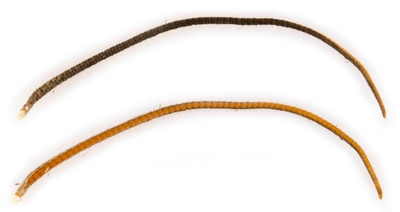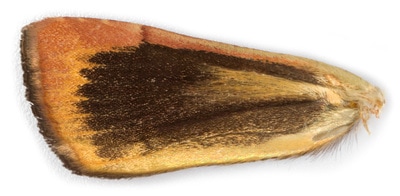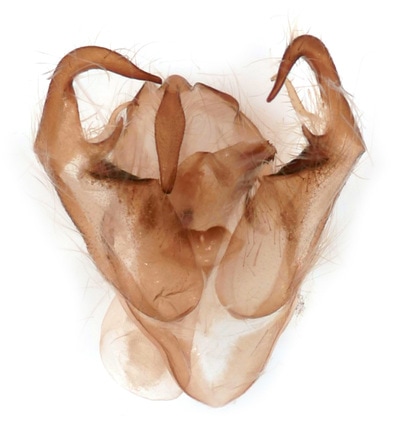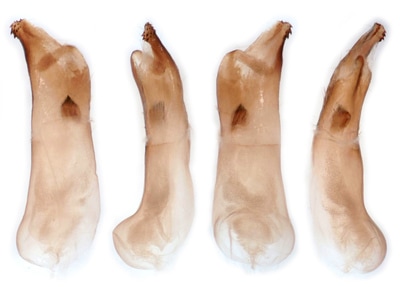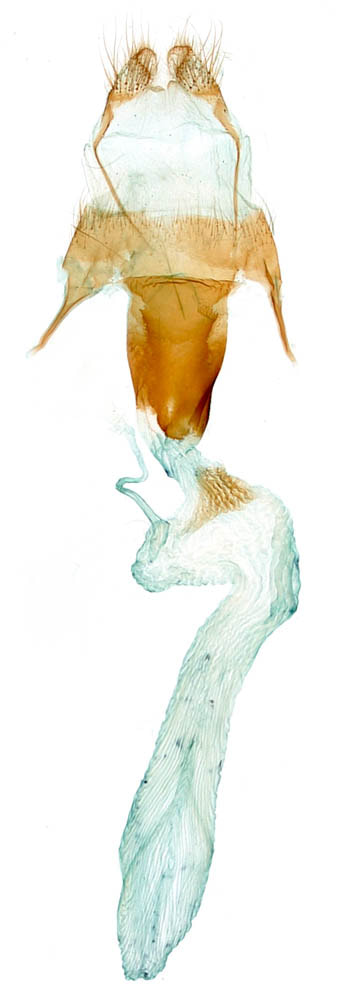73.348 Noctua janthe (Lesser Broad-bordered Yellow Underwing)
fw: 16-20mm (Waring & Townsend), ws: 34-44mm (MBGBI9); Jul-Sep; various herbaceous and woody plants; common throughout GB.
ID: The contrasting pale green of the collar (patagia) which is 'continued' onto the base of the costa is a good feature for recognising this species. Forewing ground colour deep purplish-brown clouded blue-grey; markings obscure but oval and kidney usually at least partly outlined whitish, and subterminal line may be whitish; distal 2/3 of costa red-brown, this colour expanding as a triangular wedge containing 3 whitish costal spots near the apex; hindwing bright yellow with a broad subterminal fascia, and a dorsal blackish smudge continuing to the wing base, the costa being largely yellow. Antenna finely setose in both sexes.
Very similar to N.janthina (Langmaid's Yellow Underwing) - identification of which is covered by the Difficult Species Guide and at DIssection Group. See N.janthe vs N.janthina for a comparison of the two species.
The hindwing upperside provides the best identification feature: in N.janthina the black subterminal fascia is continued along the costa and the blackish dorsobasal smudge is darker and more extensive so that the hindwing appears black with a central yellow spot, rather than yellow with a black border. This hindwing difference is more apparent in male than female N.janthina (implying sexual dimorphism in N.janthina). On the forewing underside both species show an extensive blackish basal area and a brownish terminal band. In N.janthe the distal margin of the black basal patch extends between veins as teeth and the terminal colour is yellow-brown; in N.janthina the distal margin is smooth and the terminal colour dull brown. DSG suggests that the forewing underside features do not provide absolute separation of the species.
Male genitalia: Both DSG and Dissection Group describe and illustrate the only genital difference as affecting the basal diverticulum of the everted aedeagus, the diverticulum being narrow in N.janthina and broad in N.janthe. However, this feature is variable within each species and intermediates are found.
Female genitalia:
Both DSG and Moth Dissection describe and illustrate a longer and narrower corpus bursae in N.janthe. In the specimens shown in DSG and at Moth Dissection the ratio of the length:breadth of the corpus bursae (length measured from the anterior sclerotised margin of the ductus bursae to the apex of the corpus bursae; breadth at widest point anterior to the bend) gives 3.6-4.5 in N.janthina and 5.5-5.7 in N.janthe. For my preparations the ratios are 2.5 & 2.7 for N.janthina and 3.2 and 3.4 for N.janthe. I have no clear explanation for why preparations at Moth Dissection appear longer and narrower than mine.
Very similar to N.janthina (Langmaid's Yellow Underwing) - identification of which is covered by the Difficult Species Guide and at DIssection Group. See N.janthe vs N.janthina for a comparison of the two species.
The hindwing upperside provides the best identification feature: in N.janthina the black subterminal fascia is continued along the costa and the blackish dorsobasal smudge is darker and more extensive so that the hindwing appears black with a central yellow spot, rather than yellow with a black border. This hindwing difference is more apparent in male than female N.janthina (implying sexual dimorphism in N.janthina). On the forewing underside both species show an extensive blackish basal area and a brownish terminal band. In N.janthe the distal margin of the black basal patch extends between veins as teeth and the terminal colour is yellow-brown; in N.janthina the distal margin is smooth and the terminal colour dull brown. DSG suggests that the forewing underside features do not provide absolute separation of the species.
Male genitalia: Both DSG and Dissection Group describe and illustrate the only genital difference as affecting the basal diverticulum of the everted aedeagus, the diverticulum being narrow in N.janthina and broad in N.janthe. However, this feature is variable within each species and intermediates are found.
Female genitalia:
Both DSG and Moth Dissection describe and illustrate a longer and narrower corpus bursae in N.janthe. In the specimens shown in DSG and at Moth Dissection the ratio of the length:breadth of the corpus bursae (length measured from the anterior sclerotised margin of the ductus bursae to the apex of the corpus bursae; breadth at widest point anterior to the bend) gives 3.6-4.5 in N.janthina and 5.5-5.7 in N.janthe. For my preparations the ratios are 2.5 & 2.7 for N.janthina and 3.2 and 3.4 for N.janthe. I have no clear explanation for why preparations at Moth Dissection appear longer and narrower than mine.
§1 Newborough Forest, Anglesey; 29/07/2008; fw 18.2mm
§2 Westcliff-on-sea, Essex; 08/07/2010; male; fw 18.0mm
§3 Foulness, Essex; 20/07/2013; female
§4 Seathwaite, Cumbria; 27/07/2016; male; fw 16.0mm
§5 Bampton Grange, Cumbria; 01/08/2017; male
§6 St Marys, Isles of Scilly; 06/10/2020; female; fw 19.2mm (Female genitalia from this specimen are shown here and may be N.tertia)
§7 ??; male
§8 Foulness, Essex; 07/07/2023; female; fw 19.4mm
§9 Inveruglas, Inverness-shire; 30/07/2023; female; fw 18.4mm
All images © Chris Lewis
§2 Westcliff-on-sea, Essex; 08/07/2010; male; fw 18.0mm
§3 Foulness, Essex; 20/07/2013; female
§4 Seathwaite, Cumbria; 27/07/2016; male; fw 16.0mm
§5 Bampton Grange, Cumbria; 01/08/2017; male
§6 St Marys, Isles of Scilly; 06/10/2020; female; fw 19.2mm (Female genitalia from this specimen are shown here and may be N.tertia)
§7 ??; male
§8 Foulness, Essex; 07/07/2023; female; fw 19.4mm
§9 Inveruglas, Inverness-shire; 30/07/2023; female; fw 18.4mm
All images © Chris Lewis
Page published 15/03/2017 (§1-4) | §5 added 06/01/2018 | §6 added 08/12/2020 | §7 added 27/01/2023 | §8 added 01/10/2023 |
§9 added and female genitalia text amended 23/12/2023
§9 added and female genitalia text amended 23/12/2023










